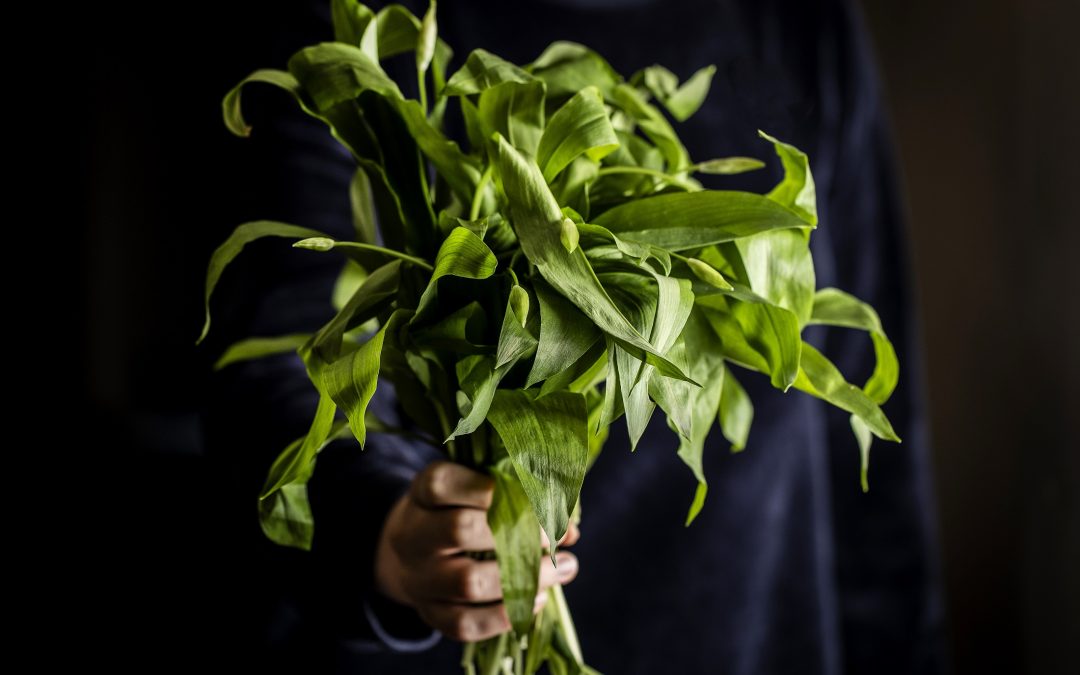If you are new to foraging, then Wild Garlic is a great place to start. It is a prolific plant that is easy to identify and particularly delicious too!
When & where to look
Wild Garlic favours damp conditions and is often found in British woodlands, shady lanes, hedgerows or near riverbanks towards from March until June. If you know of a good bluebell wood then take a look there – they like the same type of soil so chances are Wild Garlic will grow there too! The leaves are at their most flavoursome before the flowers open when they are bright green in colour. As they start to age the leaves begin to turn yellow and the flavour is less strong. The flowers are usually seen in May and June.
Identifying Wild Garlic
Wild Garlic grows in dense clusters from single stems and gives of a pleasant garlicky smell – you will probably smell it before you see it! White star-shaped flowers tend to appear in May and June time and appear in a cluster at the end of an upright stem. The leaves are spear-shaped have a single main vein and come from the base of the plant on an individual green-coloured stem.
There are a couple of plants that it is possible to confuse with Wild Garlic. The usual sources of confusion are young Lords and Ladies leaves, Lily of the Valley and Autumn Crocus – these are all toxic so it is important to take care when foraging. The best test is to crush a leaf and use your nose – if it smells of garlic it is garlic. This website has some great notes on identifying Wild Garlic and the lookalikes that you can potentially confuse it with.
What to do with Wild Garlic
When Wild Garlic is in season, you can use it in the same way you would use regular garlic bulbs from the supermarket. The flavour is however milder. The leaves have a pleasant, mellow taste and are delicious when used raw in salads, sandwiches or finely chopped as a garnish. They can also be used in the place of basil in homemade pesto. When cooked you can prepare and serve the leaves as you would spinach, and the leaves can also be used in soups, sauces and pasta dishes.
The stalks and flower buds can be added unopened to salads or stir fries for a punchy, garlicky hit, whilst the open flowers can also be used in salads.
Notes on Foraging
It is important to forage responsibly. Always be sure you can positively identify a plant before you pick it, and never eat any plant you are unsure of.
You should only pick from areas that have a plentiful supply. Forage in areas where you can find the food in abundance and only collect a small amount for personal use. You should never strip an area as this could damage the species and deny wildlife a valuable food source, as well as denying other foragers the chance to collect. You should also be mindful about habitats
In certain areas plant species are protected and so it is important to do some research and seek permission from the landowner before you start gathering. You mush never pick protected species or cause permanent damage. Britain’s wild plants are protected under The Wildlife and Countryside act (1981). It is illegal to dig up or remove a plant. If in doubt, why not take part in a foraging class with an expert to learn the basics.
Here at The Falcon in Buntingford Chef Kieren likes to use seasonal ingredients for fresher and tastier dishes. Wild Garlic is only around for a few weeks in the springtime and so we like to make the most of it while it’s around!

